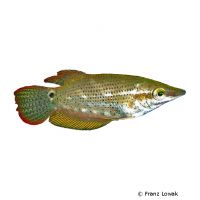Frail Gourami (Ctenops nobilis)
| Frail Gourami Ctenops nobilis | |
|---|---|
| Name | Frail Gourami |
| Name Lat. | Ctenops nobilis |
| Family | Gouramies |
| Family lat. | Osphronemidae |
| Order | Labyrinth Fishes |
| Order lat. | Anabantiformes |
| Origin | Southeast Asia |
| Habitat | Streams, ponds |
| Diet | Carnivore |
| pH | 5.0-7.5 |
| Behavior | Predatory |
| Keeping | Individual |
| Care Level | Difficult |
| Reproduction | Mouthbrooder |
| Breeding | Moderately difficult |
| Life Span | 1-3 years |
| Protection | No |
| Metric Units | |
| Size | 8-10 cm |
| Temperature | 15-25 °C |
| Hardness | 2-12 °dH |
| Aquarium | 100 cm / 200 l |
| US Units | |
| Size | 3.1"-3.9" |
| Temperature | 59-77 °F |
| Hardness | 36-214 ppm |
| Aquarium | 50 gal |
Distribution and habitat
The range of the pointed-headed gourami is the Ganges and Brahmaputra river systems north of their confluence (India, Bangladesh). There they live in slow-flowing and stagnant waters with dense vegetation, such as rivers, streams, lakes and ponds.
Maintenance
The aquarium should have dense planting with many roots as hiding places. A dark substrate with peat and foliage (e.g. sea almond leaves) and subdued light (floating plant cover) is ideal.
No ammonia, ammonium and nitrite should be detectable, the nitrate value should not exceed 100 mg/l. To ensure the water quality and oxygen content, a filter and heater adapted to the aquarium size is required, as well as lighting for the species-appropriate day-night rhythm of the animals.
Diet
They prefer live food, accordingly the food offer consists of cyclops, daphnia, artemia, mysis, and mosquito larvae, which is also accepted in frozen form, supplemented with commercially available, frozen special food mixtures. Also high-quality dry food (flakes, granules) is accepted after habituation. The food is preferably accepted from the water surface. Food lying on the bottom is usually ignored.
Feed only as much as is eaten within a few minutes. Regular and varied feeding promotes health and prevents deficiency symptoms.
Behaviour and compatibility
They are intraspecific incompatible. Also other fish of similar shape and coloration are usually perceived as enemies. Keeping several animals is only possible in a large, richly structured tank to be mutually out of sight. With other peaceful and not too small fish they can be socialized, but better is the care in a species tank.
Basically, only mutually compatible fish species with similar demands on water quality and water temperature may be socialized.
Sex dimorphism
In the male, the caudal and anal fins are fringed with red.
Reproduction and breeding
Mouthbrood is carried out by the male. Mating takes place near the ground, the male wraps around the female in a U-shape. The eggs fall on the anal and caudal fin of the male, the female collects them and spits them in front of the male's mouth. The latter receives the eggs in his throat pouch for further mouth brooding. From the 9th day the young fish are released.
The fry must be fed several times a day with special rearing food (dust food, Artemia nauplii). In a community tank breeding is hardly possible, because the fry are easy prey here.
Important
They have an additional respiratory organ, the so-called labyrinth (suprabranchial organ) with which they breathe atmospheric air and can suffocate if this is not possible. The air temperature in the breathing area must not be below the water temperature!
They are susceptible to diseases. Salt additions, maximum 1 teaspoon per 20 l aquarium water, promote the well-being, possibly also inhibit disease germs in their development or even kill them.
The well-being of the fish should be checked regularly. The temperature should be checked daily, the pH value, hardness and nitrate value at least every 14 days. A regular partial water change is recommended, even if the pollutant load has not yet reached the upper limit. Sudden changes in water quality should be avoided. Newly introduced fish must be accustomed slowly to the water in the aquarium.
Further literature can be found in your pet store.
References
Text: petdata; Image: Franz Lowak
Source: BMELV (1998): Tierschutzgutachten - Haltung von Zierfischen (Süßwasser); RIEHL & BAENSCH (2004): Aquarien Atlas Bd. 3, Mergus Verlag; ENGELMANN (2005): Zootierhaltung - Tiere in menschlicher Obhut: Fische, Verlag Harri Deutsch
- Gemäß § 21 Abs. 5 Tierschutzgesetz idgF
